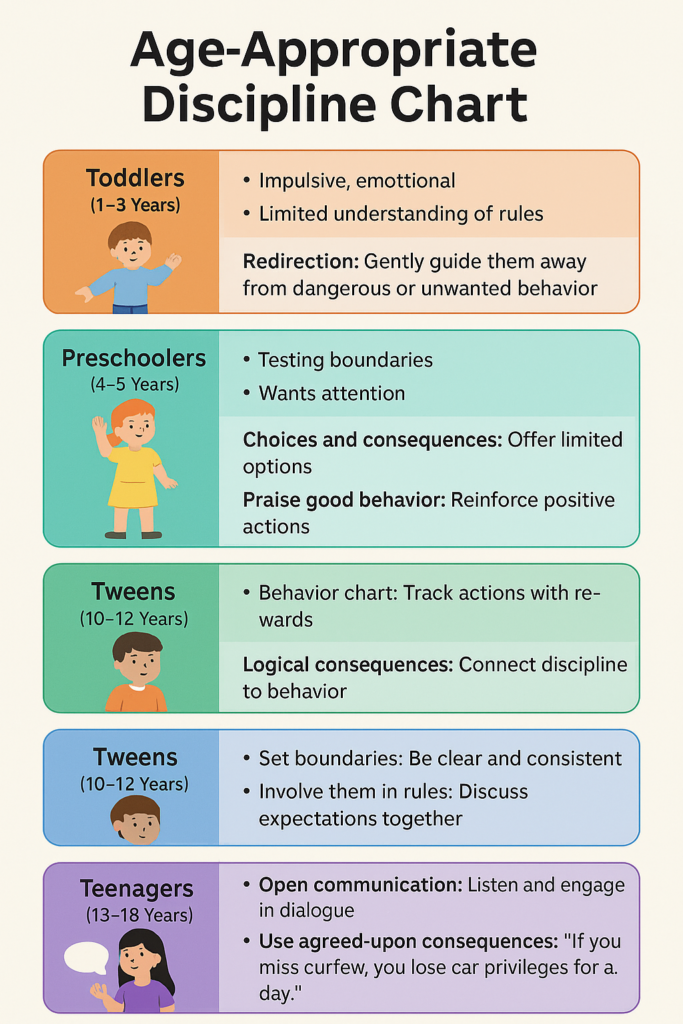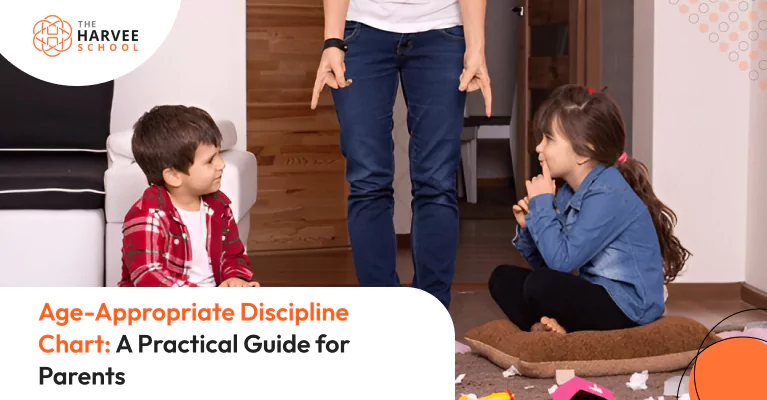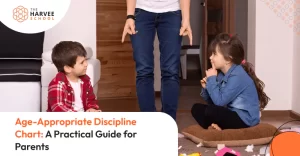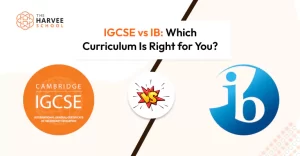Age-Appropriate Discipline Chart: A Practical Guide for Parents
As a new parent, disciplining your child might feel overwhelming. You want to correct bad behavior, but also nurture their confidence and development. The truth is—there’s no one-size-fits-all method. Children behave differently depending on their age, so your discipline approach must grow with them.
This is where an age-appropriate discipline chart becomes a helpful tool. It gives you clear, age-wise strategies for guiding your child’s behavior in a way they understand and respond to—without yelling, fear, or confusion.
Let’s break it down stage by stage so you know exactly what to expect and how to respond effectively.
What Is an Age-Appropriate Discipline Chart?
An age-appropriate discipline chart outlines the most suitable discipline strategies for children at different developmental stages. It helps parents choose techniques that are both fair and effective, reducing frustration and promoting better behavior over time.
When you discipline according to your child’s understanding and emotional maturity, they learn faster—and your bond grows stronger.
Why Use Age-Specific Discipline Methods?
Children develop in stages. What works for a toddler won’t work for a 10-year-old, and how you handle your teenager will be completely different.
Benefits of using an age-appropriate discipline chart:
- Avoids unrealistic expectations
- Prevents unnecessary conflicts
- Encourages consistent behavior
- Builds long-term respect and cooperation
The Age-Appropriate Discipline Chart: Stage-by-Stage Guidance
Below is a clear breakdown of discipline strategies for each major developmental stage, designed to guide parents with simple, real-world advice.
1. Toddlers (1–3 Years Old): Teaching Right from Wrong
Toddlers are curious, impulsive, and easily overwhelmed by emotions. They don’t yet understand cause and effect, so discipline must be simple and immediate.
Best Discipline Techniques:
- Redirection: Redirect their attention calmly by steering them toward a safer or more appropriate activity when they engage in unsafe or undesirable behavior. If they grab something unsafe, offer a toy instead.
- Time-out (brief and calm): Use 1 minute per year of age in a quiet spot.
- Set boundaries consistently: Always say “no” firmly when it matters—like biting or hitting.
- Use simple language: Say “No touching. Hot.” or “We don’t hit.”
Example Situation:

Your toddler throws food. Instead of yelling, say “Food stays on the plate,” and remove the plate briefly.
2. Preschoolers (4–5 Years Old): Building Self-Control
Preschoolers begin to understand rules, but they’re still testing limits. They seek attention and may act out if ignored.
Best Discipline Techniques:
- Offer clear choices: “You can put on your pajamas or I will help you.”
- Praise good behavior: Say, “Great job putting your toys away!”
- Explain consequences: “If you yell, we’ll stop the game.”
- Time-out with reflection: After calming down, ask, “Why did we take a break?”
Example Situation:
Your child refuses to share. Calmly remove the toy and explain, “When we don’t share, we can’t play with it.”
3. Early School Age (6–9 Years Old): Encouraging Responsibility
Children at this age can understand rules and consequences. They start to care more about fairness and social approval.
Best Discipline Techniques:
- Logical consequences: If they break a toy, they help clean it up or save for a new one.
- Use behavior charts: Reward good behavior with stickers or small privileges.
- Have calm, clear talks: Ask, “What happened?” and let them explain.
- Follow through: Say what you mean and stick to the consequences.
Example Situation:
If your child forgets their homework, don’t do it for them. Let them face the teacher’s response and help them plan better next time.
4. Tweens (10–12 Years Old): Fostering Independence
Tweens want to be more independent but still need strong guidance. They may push back but still value your approval.
Best Discipline Techniques:
- Set firm but fair rules: “Phone can be used only after homework.”
- Let natural consequences happen: Forgot lunch? They’ll remember next time.
- Let them help create rules: “What should our weekend screen time limit be?”
- Talk about values and respect: Focus on teaching instead of just punishing.
Example Situation:
If your tween talks back, calmly say, “We don’t speak to each other that way. Take a moment, then we’ll talk again.”
5. Teenagers (13–18 Years Old): Guiding Through Mutual Respect
Teens are forming their identity and want independence. They may challenge authority, but consistency and open communication are key.
Best Discipline Techniques:
- Have honest discussions: “I noticed your grades dropped. What’s going on?”
- Establish consequences together in advance: “If you come home past curfew, you’ll lose car privileges for the next day.”
- Respect their privacy: Give space, but stay involved.
- Focus on accountability: Help them learn from mistakes without shame.
Example Situation:
If your teen lies, address it calmly: “I need honesty. Let’s figure out why you didn’t tell the truth and how to fix it.”
Age-Appropriate Discipline Chart Summary
| Age Group | Child’s Needs | Discipline Tools |
| 1–3 yrs | Safety, clear limits | Redirection, simple no’s, short time-outs |
| 4–5 yrs | Choices, attention | Praise, time-outs, clear rules |
| 6–9 yrs | Logic, structure | Charts, logical consequences, talks |
| 10–12 yrs | Independence, responsibility | Shared rules, natural consequences |
| 13–18 yrs | Respect, trust | Conversations, consistency, boundaries |
Quick Tips for Discipline Success
Stay consistent – Changing rules often causes confusion.
Be calm, not reactive – Yelling teaches fear, not respect.
Model good behavior – Kids learn by watching.
Balance love and limits – Discipline works best in a loving environment.
Adapt with age – Review and update your approach as your child grows.
Final Thoughts
Discipline is not about punishment—it’s about guiding children to develop essential life skills like respect, responsibility, and self-discipline.
Using an age-appropriate discipline chart helps you guide your child through every stage of development with confidence and care.Whether you’re dealing with toddler tantrums or teenage mood swings, the right approach at the right age can make parenting smoother—and your bond with your child stronger.
Frequently Asked Questions
Discipline can start around age 1 when your child starts exploring and testing boundaries.
Take a breath, walk away if needed, and return when calm. Your response teaches them emotional control.
Reevaluate your strategy. You might need to adjust for their current age or seek guidance from a parenting coach or pediatrician.






